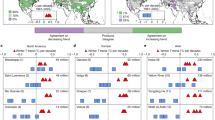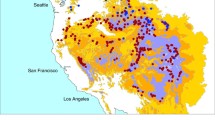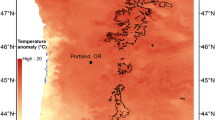Abstract
Climate change could significantly influence seasonal streamflow and water availability in the snowpack-fed watersheds of Washington, USA. Descriptions of snowpack decline often use linear ordinary least squares (OLS) models to quantify this change. However, the region’s precipitation is known to be related to climate cycles. If snowpack decline is more closely related to these cycles, an OLS model cannot account for this effect, and thus both descriptions of trends and estimates of decline could be inaccurate. We used intervention analysis to determine whether snow water equivalent (SWE) in 25 long-term snow courses within the Olympic and Cascade Mountains are more accurately described by OLS (to represent gradual change), stationary (to represent no change), or step-stationary (to represent climate cycling) models. We used Bayesian information-theoretic methods to determine these models’ relative likelihood, and we found 90 models that could plausibly describe the statistical structure of the 25 snow courses’ time series. Posterior model probabilities of the 29 “most plausible” models ranged from 0.33 to 0.91 (mean = 0.58, s = 0.15). The majority of these time series (55 %) were best represented as step-stationary models with a single breakpoint at 1976/77, coinciding with a major shift in the Pacific Decadal Oscillation. However, estimates of SWE decline differed by as much as 35 % between statistically plausible models of a single time series. This ambiguity is a critical problem for water management policy. Approaches such as intervention analysis should become part of the basic analytical toolkit for snowpack or other climatic time series data.



Similar content being viewed by others
References
Adam, J. C., Hamlet, A. F., & Lettenmaier, D. P. (2009). Implications of global climate change for snowmelt hydrology in the twenty-first century. Hydrological Processes 23, 962–972.
Casola, J. H., Cuo, L., Livneh, B., Lettenmaier, D. P., Stoelinga, M. T., Mote, P. W., & Wallace, J. M. (2009). Assessing the impacts of global warming on snowpack in the Washington Cascades. Journal of Climate 22, 2758–2772.
Bai, J., & Perron, P. (2003). Computation and analysis of multiple structural change models. Journal of Applied Econometrics, 18, 1–22.
Box, G. E. P., & Tiao, G. C. (1975). Intervention analysis with applications to economic and environmental problems. Journal of the American Statistical Society, 70(349), 70–79.
Burnham, K. P., & Anderson, D. R. (2002). Model Selection and Multi-Model Inference: A Practical Information-Theoretic Approach. 2nd edition. New York: Springer.
Chang, I., Tiao, G. C., & Chen, C. (1988). Estimation of time series parameters in the presence of outliers. Technometrics, 30(2), 193–204.
CIG (2012). Impacts of natural climate variability on Pacific Northwest climate. Resource document. Climate Impacts Group, University of Washington. http://cses.washington.edu/cig/pnwc/clvariability.shtml. Accessed 2 August 2011.
Cornwall, W. (2007). How one number touched off big climate-change fight at UW. Seattle Times, March 15, 2007.
Elsner, M. M., Cuo, L., Voisin, N., Deems, J., Hamlet, A. F., Vano, J. A., et al. (2010). Implications of 21st century climate change for the hydrology of Washington State. Climatic Change, 102(1–2), 225–260.
Frank, D., Wilson, R., & Esper, J. (2005). Synchronous variability changes in alpine temperature and tree-ring data over the past two centuries. Boreas, 34(4), 498–505.
Gottfried, G. J., Neary, D. G., & Ffolliott, P. F. (2002). Snowpack-runoff relationships for mid-elevation snowpacks on the Workman Creek watersheds of central Arizona. Research Paper RMRS-RP-33. Fort Collins: U.S. Forest Service, Rocky Mountain Research Station.
Granger, C. W. J., & Engle, R. F. (1987). Econometric forecasting: a brief survey of current and future techniques. Climatic Change, 11(1–2), 117–139.
Hare, S., & Mantua, N. (2002). The Pacific Decadal Oscillation. Journal of Oceanography, 58, 35–44.
Kennedy, A. M., Garen, D. C., & Koch, R. W. (2009). The association between climate teleconnection indices and Upper Klamath Streamflow: the Trans-Niño Index. Hydrological Processes, 23, 973–984.
Matthews, K. B., Rivington, M., Blackstock, K., McCrum, G., Buchan, K., & Miller, D. G. (2011). Raising the bar?—the challenges of evaluating the outcomes of environmental modelling and software. Environmental Modelling & Software, 26(3), 247–257.
Meehl, G. A., Hu, A., & Santer, B. D. (2009). The mid-1970s climate shift in the Pacific and the relative roles of forced versus inherent decadal variability. Journal of Climate, 22, 780–792.
Mestas-Nuñez, A. M., & Miller, A. J. (2006). Interdecadal variability and climate change in the eastern tropical Pacific: a review. Progress In Oceanography, 69, 267–284.
Mote, P. (2006). Climate-driven variability and trends in mountain snowpack in western North America. Journal of Climate, 19, 6209–6220.
Mote, P., Hamlet, A. F., Clark, M. P., & Lettenmaier, D. P. (2005). Declining mountain snowpack in western North America. Bulletin of the American Meteorological Society, 86, 39–49.
Mote, P., Hamlet, A. F., & Salathé, E. (2008). Has spring snowpack declined in the Washington Cascades? Hydrology and Earth Systems Sciences, 12, 193–206.
Nickels, G. (2007). State should find ways to protect City Light’s climate-protection efforts. Seattle Times, February 7, 2007.
NRCS. (1984). Snow survey sampling guide. Agriculture handbook 169. Washington: U.S. Department of Agriculture, Natural Resources Conservation Service.
Pederson, G. T., Gray, S. T., Fagre, D. B., & Graumlich, L. J. (2006). Long-duration drought variability and impacts on ecosystem services: a case study from Glacier National Park, Montana. Earth Interactions, 10(1), 1–28.
Pelto, M. (2008). Impact of climate change on North Cascade alpine glaciers, and alpine runoff. Northwest Science, 82(1), 65–75.
Petersen, W. T., & Schwing, F. B. (2003). A new climate regime in northeast Pacific ecosystems. Geophysical Research Letters, 20, 1896–1899.
Pierce, D. W., Barnett, T. P., Hidalgo, H. G., Das, T., Bonfils, C., Santer, B. D., et al. (2008). Attribution of declining western U.S. snowpack to human effects. Journal of Climate, 21, 6425–6444.
R Development Core Team. (2009). R: a language and environment for statistical computing. Vienna: R Foundation for Statistical Computing.
Raftery, A. E. (1995). Bayesian model selection in social research. Sociological Methodology, 25, 111–163.
Stewart, I. T., Cayan, D. R., & Dettinger, M. D. (2005). Changes toward earlier streamflow timing across western North America. Journal of Climate, 18, 1136–1155.
Tsay, R. S. (1988). Outliers, level shifts, and variance changes in time series. Journal of Forecasting, 7, 1–20.
Wilson, R., Wiles, G., D’Arrigo, R., & Zweck, C. (2007). Cycles and shifts: 1,300 years of multi-decadal temperature variability in the Gulf of Alaska. Climate Dynamics, 28(4), 425–440.
Yang, Y. (2005). Can the strengths of AIC and BIC be shared? A conflict between model identification and regression estimation. Biometrika, 92, 937–950.
Zeileis, A., Leisch, F., Hornik, K., & Kleiber, C. (2002). strucchange: an R package for testing for structural change in linear regression models. Journal of Statistical Software, 7(2), 1–38.
Zeileis, A., Kleiber, C., Kraemer, W., & Hornik, K. (2003). Testing and dating of structural changes in practice. Computational Statistics and Data Analysis, 44, 109–123.
Zeileis, A., Shah, A., & Patnaik, I. (2008) Testing, monitoring, and dating structural changes in maximum likelihood models. Research Report 70. Vienna, Austria: Department of Statistics and Mathematics, WU Vienna University of Economics and Business.
Author information
Authors and Affiliations
Corresponding author
Electronic supplementary material
Below is the link to the electronic supplementary material.
ESM 1
(DOC 3277 kb)
Rights and permissions
About this article
Cite this article
Barry, D., McDonald, S. Climate change or climate cycles? Snowpack trends in the Olympic and Cascade Mountains, Washington, USA. Environ Monit Assess 185, 719–728 (2013). https://doi.org/10.1007/s10661-012-2587-z
Received:
Accepted:
Published:
Issue Date:
DOI: https://doi.org/10.1007/s10661-012-2587-z




